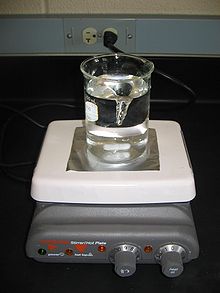Stir bar

A stir bar mixing a solution on a combined hot-plate magnetic-stirrer device. The left knob controls the stirring rate and the right knob controls heating.
|
|
| Other names | Magnetic mixer |
|---|---|
| Uses | Liquid mixing |
| Inventor | Arthur Rosinger |
| Related items |
Stir bar Vortex mixer Static mixer |
A magnetic stirrer or magnetic mixer is a laboratory device that employs a rotating magnetic field to cause a stir bar (also called "flea") immersed in a liquid to spin very quickly, thus stirring it. The rotating field may be created either by a rotating magnet or a set of stationary electromagnets, placed beneath the vessel with the liquid.
Magnetic stirrers are often used in chemistry and biology, where they can be used inside hermetically closed vessels or systems, without the need for complicated rotary seals. They are preferred over gear-driven motorized stirrers because they are quieter, more efficient, and have no moving external parts to break or wear out (other than the simple bar magnet itself). Magnetic stir bars work well in glass vessels commonly used for chemical reactions, as glass does not appreciably affect a magnetic field. The limited size of the bar means that magnetic stirrers can only be used for relatively small experiments, of 4 liters or less. Stir bars also have difficulty in dealing with viscous liquids or thick suspensions. For larger volumes or more viscous liquids, some sort of mechanical stirring is typically needed.
Because of its small size, a stirring bar is more easily cleaned and sterilized than other stirring devices. They do not require lubricants which could contaminate the reaction vessel and the product. Magnetic stirrers may also include a hot plate or some other means for heating the liquid.
Arthur Rosinger of Newark, New Jersey, U.S.A. obtained US Patent 2,350,534, titled Magnetic Stirrer on 6 June 1944, having filed an application therefore on 5 October 1942. Mr. Rosinger's patent includes a description of a coated bar magnet placed in a vessel, which is driven by a rotating magnet in a base below the vessel. Mr. Rosinger also explains in his patent that coating the magnet in plastic or covering it with glass or porcelain makes it chemically inert.
The plastic-coated bar magnet was independently invented in the late 1940s by Edward McLaughlin, of the Torpedo Experimental Establishment (TEE), Greenock, Scotland, who named it the 'flea' because of the way it jumps about if the rotating magnet is driven too fast.
...
Wikipedia
